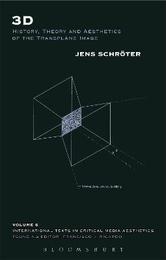
|
3D: History, Theory and Aesthetics of the Transplane Image
Paperback / softback
Main Details
| Title |
3D: History, Theory and Aesthetics of the Transplane Image
|
| Authors and Contributors |
By (author) Jens Schroeter
|
| Series | International Texts in Critical Media Aesthetics |
|---|
| Physical Properties |
| Format:Paperback / softback | | Pages:496 | | Dimensions(mm): Height 216,Width 140 |
|
| Category/Genre | Theory of art
Art History |
|---|
| ISBN/Barcode |
9781441167262
|
| Classifications | Dewey:302.2301 |
|---|
| Audience | | Tertiary Education (US: College) | | Professional & Vocational | |
|---|
| Illustrations |
65 illus
|
|
Publishing Details |
| Publisher |
Bloomsbury Publishing Plc
|
| Imprint |
Bloomsbury Academic USA
|
| Publication Date |
13 March 2014 |
| Publication Country |
United States
|
Description
There is a blind spot in recent accounts of the history, theory and aesthetics of optical media: namely, the field of the three-dimensional, or trans-plane, image. It has been widely used in the 20th century for very different practices - military, scientific and medical visualization - precisely because it can provide more spatial information. And now in the 21st century, television and film are employing the method even more. Appearing for the first time in English, Jens Schroeter's comprehensive study of the aesthetics of the 3D image is a major scholarly addition to this evolving field. Citing case studies from the history of both technology and the arts, this wide-ranging and authoritative book charts the development in the theory and practice of three-dimensional images. Discussing and analyzing the transformation of the socio-cultural and technological milieu, Schroeter has produced a work of scholarship that combines impressive historical scope with contemporary theoretical arguments.
Author Biography
Jens Schroeter is Professor of Theory and Practice of Multimedia Systems in the Department of Media Studies, University of Siegen, Germany, and is also the co-editor, with Stefan Rieger, of Das holographische Wissen, Berlin (2009).
ReviewsWhat if, instead of writing the history of those things that have become the cultural dominant, we were to write the history of the overlooked - of those other, non-victorious cultural forms that the march of history pushed into the shade? And what if the history in question is that of visual media, from Daguerre to the present? Jens Schroeter's inquiry begins as a project of 'minor' history, tracing the development of one among the many visual media existing in the shadows of the dominant: the 3-D (or 'transplane') image. In the course of excavating this particular terrain something larger and more dangerous is unearthed: the systematic blind-spots, exclusions, red herrings, and cul-de-sacs that have helped to shape the shiny new discipline of the history of visuality. Warning: this book may cause the reader to lose faith in a number of cherished beliefs concerning visual regimes and their periodization, and the viability of such concepts as embodied spectatorship, the physiological paradigm of vision, and the theoretical fiction known as 'the observer. -- Norman Bryson, Professor of Art History, Theory, and Criticism, University of California, San Diego, USA Schroeter's book gives an in-depth insight into the puzzling amalgam of 3D images, for the first time in media history sufficiently exploring the technical difference of stereoscopic and holographic '3D', as well as the theoretical implications of the respective methods. Challenging Jonathan Crary's seminal studies of the stereoscopic image (Techniques of the Observer), Jens Schroeter demonstrates that the history of 3D-images is not changing abruptly, but that there a parallel threads in the evolution of visual media according to various hypotheses about the nature of light. -- Stephan Gunzel, Professor of Media Theory, BTK University of Applied Sciences, Germany An intriguing and insightful study. -- Sean Johnston, Professor of Science, Technology and Society, University of Glasgow, UK
|